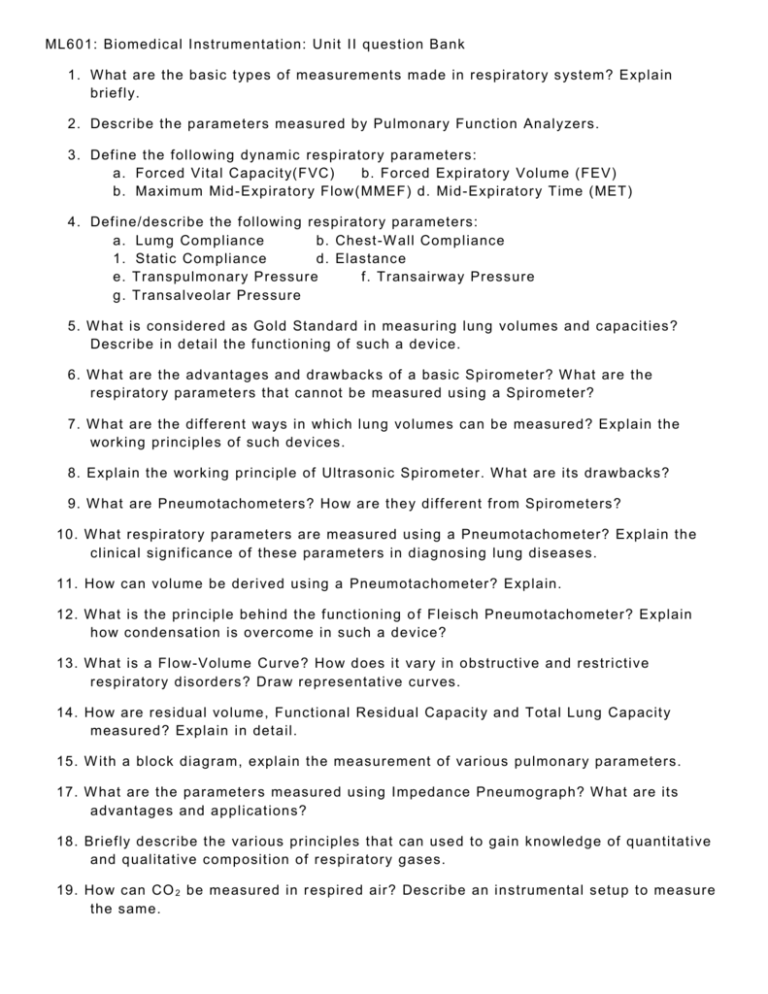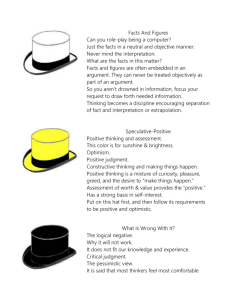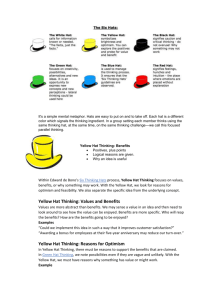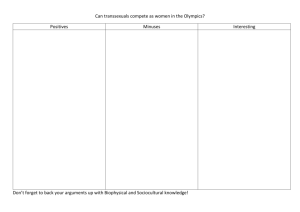ML601_QB2
advertisement

ML601: Biomedical I nstrumentation: Unit II question Bank 1. W hat are the basic t ypes of measurements made in respir ator y syst em? Explain brief ly. 2. Descr ibe the parameters measured by Pulmonar y Funct ion Analyzers. 3. Def ine the f ollowing dynam ic respirator y parameters: a. Forced Vital Capacit y(FVC) b. Forced Expirator y Volume (FEV) b. Maximum Mid-Expiratory Flow( MMEF) d. Mid-Expirat or y Time ( MET) 4. Def ine/describe the f ollowing respirator y parameters: a. Lumg Compliance b. Chest-W all Compliance 1. Static Compliance d. Elastance e. Transpulmonar y Pressure f . Transair way Pressure g. Transalveolar Pressure 5. W hat is considered as Gold Standard in measur ing lung volumes and capacit ies? Descr ibe in detail the f unctioning of such a device. 6. W hat are the advantages and drawbacks of a basic Spirom eter? W hat are the respir ator y paramete rs that cannot be measured using a Spir ometer? 7. W hat are the diff erent ways in which lung volumes can be measured? Explain t he working principles of such devices. 8. Explain the working principle of Ultrasonic Spir ometer. W hat are its drawbacks? 9. W hat are Pneumotachometers? How are they dif f erent f rom Spirometers? 10. W hat respirator y parameters are measured using a Pneumotachometer? Explain the clinical signif icance of these parameters in diagnosing lung diseases. 11. How can volume be der ived using a Pneumotachometer? Explain. 12. W hat is the principle behind the f unct ioning o f Fleisch Pneumo tachometer? Explain how condensat ion is overcome in such a device? 13. W hat is a Flow-Volume Cur ve? How does it var y in obstructive and restrictive respir ator y disorders? Draw representative cur ves. 14. How are residual volume, Funct ional Residual Capacit y and Total Lung Capacit y measured? Explain in detail. 15. W ith a block diagram, explain the measurement of var ious pulmonar y paramet ers. 17. W hat are the parameter s measured using Impedance Pneumograph? W hat are its advant ages and applicat ions? 18. Brief ly descr ibe t he various pr inciples that can used to gain knowledge of quantitative and qualitat ive composit ion of respir ator y gases. 19. How can CO 2 be measured in r espir ed air? Descr ibe an instrumental setup to measure the same. ML601: Biomedical I nstrumentation: Unit II question Bank 20. How can O 2 be measured in respir ed air? Descr ibe an instrumental setup to measure the same. 21. How can N 2 be measured in respired air? Descr ibe an inst rumental setup to m easure the same. 22. W hat is the need f or artif icial vent ilation? W hat are the basic parts of a manual artif icial ventilator ? 23. Classif y and describe the vent ilators based on: a. Method of init iating inspir ator y phase b. Power transmission c. Pressure pattern d. Type of saf ety limit d. Cycling control 24. W ith a neat diagram describe the pr essure -f low- volume relationships with and without pause t ime f or a ventilator. 25. Descr ibe var ious blocks and f unctioning of a microprocessor controlled vent ilat or. 26. W rite a note on: a. High f requency ventilators b. Nebulizers and humidif iers c.Aspirators








